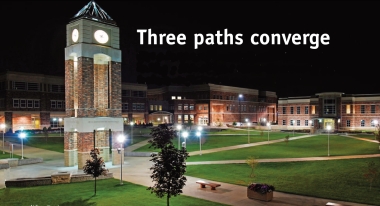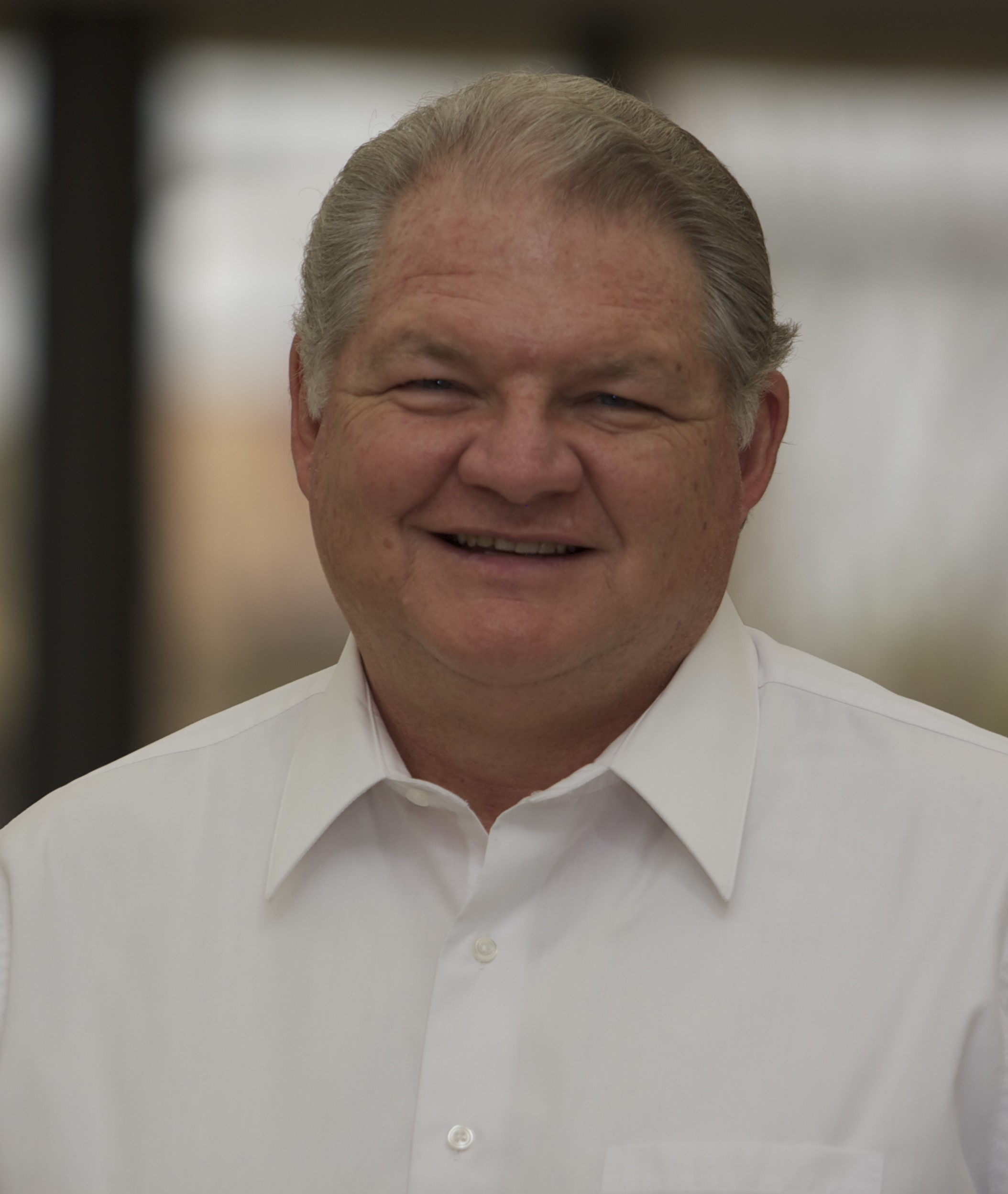
Within a month of his August 2007 election as chief executive officer of the Assemblies of God, George Wood was on Facebook and was navigating it with ease. At age 66, he had joined the social networking site before most of his peers.
The move was in keeping with his management style. "You don't build a climate today by waiting to make official pronouncements," he says. "You build it from the ground up. Leaders have to be accessible." Ignoring new communication tools can result in missed opportunities, he believes. "A conversation may be formed before you get a chance to jump in."
His availability proved handy when officials of the Assemblies of God recently attempted — for the third time — to rally support for consolidating three of its schools. On the surface, the consolidation of Central Bible College (CBC), Evangel University (pictured above), and the Assemblies of God Theological Seminary seemed logical. The campuses are within four miles of one another in Springfield, Missouri, home to the denomination's national headquarters. The schools' debt was going up, and their overall enrollment figures were not encouraging. An unwritten "non-compete understanding" prevented Evangel, a liberal arts campus, from offering courses leading to career ministry — that was CBC territory. Likewise, Central Bible College took care not to duplicate the seminary's postgraduate curriculum. The schools were vying for many of the same students, making it inevitable that they would eventually come together.
Or so it seemed.
Two failed attempts to consolidate had taught the denomination's leaders a thing or two about the challenges of building consensus among alumni and within faculty and church structures. CBC had been around since 1922; Evangel opened its doors in 1955; and the theological seminary was founded some two decades later. Each had a proud history and a deep pool of alumni. Many weren't willing to concede their alma mater's identity to a new institution. Blending faculties from the same faith tradition would seem easy by comparison, but there was little interaction among the schools' faculties — particularly between the teachers at Evangel and CBC.
"We work closely with Evangel because we're located across the parking lot from each other," says Byron Klaus, president of the Assemblies of God Theological Seminary. "We work with Central Bible College because we get a lot of students from there. But as far as the three schools coming together," he admits, "I've been in rooms with people who have worked in the same town for 20 years and who teach in the same discipline, and they don't know each other."
A winning formula
The fact that denominational leaders were able to win approval for consolidation in August 2011 was no "third-time's-the-charm" fluke. When secret ballots were tallied at the denomination's General Council meeting in Phoenix, almost 75 percent of the 2,210 assembled delegates had voted in favor of the measure. If the outcome was expected, the generous margin was a surprise.
"I was fairly confident it would pass," says Klaus, who played a major role in building support for the motion. "But then I'd check the social media and see some resistance." Signs pointing to victory began surfacing as he traveled from coast to coast to meet with constituents. "Outside the Springfield ‘bubble,' friends would say to me, ‘What's the big deal?' ‘Get on with it,' or ‘It's about time!'"
Four factors — visionary leadership, a climate of urgency, a good process, and a $5 million check — eventually worked together to reduce resistance, create consensus, and deliver the vote. Wood (who earned a law degree while serving as a pastor before he was elected to the denomination's executive leadership) was assisted by a team that had impeccable credentials and the backing of the rank and file. A key member was Robert E. Cooley, a uniquely qualified consultant who admits that his position was far from neutral. He is a graduate of CBC, and his long career has included stints as academic dean at both CBC and Evangel. He was also president of Gordon-Conwell Theological Seminary for 16 years, served a term as president of the Association of Theological Schools, is an emeritus member of In Trust's board of directors, and is currently an In Trust Governance Mentor.
 |
| Over the Labor Day weekend, 200 faculty and spouses of the three consolidating schools gathered for a retreat to build relationships. Here, leaders of the consolidation effort address the participants. From left, Robert E. Cooley; Byron Klaus, president of Assemblies of God Theological Seminary; George O. Wood, general superintendent of the Assemblies of God; Robert Spence, president of Evangel University; and Gary Denbow, president of Central Bible College. |
"I'd been involved in 13 other projects involving mergers, affiliations, consolidations, and partnerships," explains Cooley. "I knew some of the barriers we would face. I also knew that we were breaking new ground in attempting to join three institutions that have different histories yet are in the same context."
The team realized that the time to act was overdue. As at many single-purpose schools, CBC had been losing enrollment for years. Resident capacity was 750, but 500 beds were unoccupied. Across town, Evangel's student population was holding steady at 2,000. The seminary's numbers were also flat, with a decline in M.Div. students but a bump in doctoral program participation. Counting depreciation, assets were showing a decline, and the combined debt load had spiked. Financial issues aside, Wood believed that a larger, more comprehensive university would better meet the needs of the Assemblies of God denomination, which had grown in less than a century from a tiny band to a global powerhouse projected to reach 100 million worldwide members by 2020.
Building momentum slowly
Learning from what Klaus calls the "misfire" of 2005, when leaders of the Assemblies of God decided not to bring the consolidation issue to a vote because they sensed strong opposition, Cooley and Wood designed a multistep process. "In 2005 the proposal was leadership-driven, from the top down," explains Wood. "It probably failed because it didn't have buy-in from internal audiences. As a result, there was a lot of blowback. This time we had all the voices around the table. The process had authenticity that made acceptance by the church body very possible."
With a firm deadline set for early August when the church-wide General Council would convene in Phoenix, Wood's team went to work.
Step 1: Earn governing boards' support
In a historic first, the boards of directors of CBC, Evangel University, and the Assemblies of God Theological Seminary gathered in Springfield in January 2011 to develop a strategic vision for the schools. After a convincing presentation by Wood and several hours of discussion, the boards met separately to consider a resolution of consolidation that would establish a task force of 16 persons to oversee the consolidation. With varying degrees of enthusiasm, each board passed the resolution.
Step 2: Assemble a diverse and independent task force
The Consolidation Task Force that met a month later included the board chairs and presidents of the three schools; a professor from each campus, selected by colleagues; a lay donor from each institution; three representatives from the denomination's Executive Presbytery, and George Wood as chairman.
"All stakeholder groups were represented," says Cooley. "We didn't build a ‘favorable' task force. We had extreme differing viewpoints, and this was healthy. When you're dealing with questions of mission, structure, governance systems, and bylaws, you're dealing with good grounds for debate. George Wood always allowed for dissention, but he wanted it handled rationally, not emotionally. A person who got emotional could expect a confidential conversation with George."
As for the inclusion of donors, Cooley explains, "Most schools studying partnerships forget about donors. They forget that donors make investments. We considered donors to be a major stakeholder group of these schools, and so we wanted to give them a voice."
Among the first orders of business, the task force organized itself into four subcommittees. It also recommended to the three boards of directors a name for the consolidated university. Again, the decision was unanimous: Evangel. Determining how to honor CBC's name and legacy in some visible way was left for another day. Minor questions related to branding and identity - like choosing between the mascot names Crusaders (Evangel) and Spartans (CBC) - would be assigned to the campus population to encourage interaction, if and when the consolidation took place. From the beginning, "we planned to work hard to integrate the student bodies," says Wood.
Step 3: Solicit widespread input from constituents
The task force met monthly to hear reports from subcommittees working on thorny issues like governance (How do we blend three boards into one?) and structure (Should the educational system be divided into colleges, schools, departments, or programs?). The presidents of the three schools facilitated focus groups that considered each report and offered input. The task force then hammered out a mission statement, agreed to a set of core values for the consolidated institution, and methodically crafted a plan of action that it returned to the governing boards of the three schools for their approval.
"The three boards met in joint session to debate the plan that the task force gave them," recalls Cooley. "There was a little bit of modification along the way." For example, the proposed makeup of the board of trustees for the consolidated school generated much discussion before it was tweaked to reflect a different balance between ordained clergy and laity.
Step 4: Generate a rising wave of endorsements
The Assemblies of God denominational governance structure includes several layers of authority, and the task force approached each one, built its case, and earned the necessary support. The three boards of directors voted their approval in June by secret ballot and referred the proposal to the Executive Presbytery, which added its endorsement. This cleared the way for the resolution to move to the church's larger General Presbytery, whose members gave it a 91 percent positive vote before sending it on to the General Council, the biennial gathering where every congregation and ordained minister has a vote. It garnered 75 percent approval.
"Once the General Council voted, authority had spoken," says Cooley, who agreed to continue as a consultant for the implementation phase because, "When you bring three schools together, there's always a lot of work to be done."
That work will likely culminate in 2020 when all aspects of the consolidation will be in place and, it is hoped, a $50 million campaign to sustain the university as a debt-free institution will have met its goal. Other target dates come sooner. The blended Evangel University will enroll its first students in 2014, graduate its first class in 2015 and graduate its first four-year class in 2018. This, of course, is contingent upon the consolidated university's ability to satisfy the requirements set by its regional accreditation body, the Higher Learning Commission of the North Central Association of Colleges and Schools.
Dissecting the victory
 |
Byron Klaus
Photo courtesy Assemblies of God Theological Seminary |
As Assemblies of God leaders reflect on their successful efforts to date, they emphasize the importance of open communication and a $5 million gift that set the entire process in motion. Byron Klaus calls the donation a "tipping point"; George Wood refers to it as a "catalyst"; and Robert Cooley likens it to a "trigger" on a loaded gun. "Once the funds arrived, the gun went off," Cooley says. "A consolidation is expensive, and without the necessary resources it just doesn't happen."
The unsolicited gift came with a caveat. Its expressed purpose was to help blend three schools with complementary missions into one institution. This included building community among faculty members who were destined to become colleagues. Toward this end, Wood invited 200 faculty and spouses for a three-day retreat at nearby Branson, Missouri, over Labor Day weekend. "I sensed nothing but support," says Wood of the get-together. "We didn't focus on how we were going to integrate operations or academics. We simply focused on building relationships. People seemed to feel their voices had been heard and now that the decision was made by our governing body, they want to make it work."
Much effort "to make it work" will take place behind the scenes as many committees meet to sort out endless details. "The heavy lifting is ahead of us," says Byron Klaus, the current seminary president, who will guide the formation of Evangel's school of theology and church ministry. "The work we're doing right now is all about the future. That's what I have to keep in mind. This isn't about ‘now' and it isn't about me. I don't expect any pats on the backs and comments like ‘great job, great job.' But if I live long enough, I'll be able to see that our work was done right."
More information: www.ag.org has a full library of news releases, transcripts, and videos related to the three-school consolidation.
ASSEMBLIES OF GOD AT A GLANCE 
-
International. With a U.S. affiliation of about 3 million and a global membership approaching 65 million, the Assemblies of God is the world's largest Pentecostal denomination and sixth largest Christian denomination.
-
Growing. In 2010 the worldwide Assemblies of God constituency grew by 4 percent, while United States membership grew by about 2 percent.
-
Young. A third of U.S. members are under 25, and about 360,000 Assemblies of God students are in middle- and high-school grades.
-
Rich with educational institutions. The denomination has 18 affiliated colleges in the United States. One school — Bethany University, the oldest college affiliated with the Assemblies of God — closed its doors in 2011. Since 2000, total enrollment at Assemblies of God post-secondary institutions has risen 11 percent.
SOURCE: Assemblies of God
Building the case for change
Assigned to keep the Assemblies of God's far-flung constituency briefed on the consolidation issue, Juleen Turnage, the denomination's national communication director, designed a concentric pattern of releasing information. This "inside-out" approach distributes news first to persons closest to an issue and then systematically expands outward to persons with diminishing interest.
"I audited all meetings of the Consolidation Task Force so I had a clear picture of the discussions and where they were going," she explains. After each meeting, she prepared a report that she sent to the presidents of the three schools involved in the proposed consolidation. They, in turn, forwarded the release to members of their boards of trustees. Next, each president posted the release on his school's website so students, alumni, and other audiences could follow the story. Finally, all releases appeared on the denomination's website, www.ag.org.
Face-to-face communication was employed whenever possible. Immediately after Dr. George Wood presented his case for consolidation to the combined boards of the merging schools, he gave the same presentation to a gathering of the schools' full-time faculty members and administrators. A video of Wood's presentation — and a transcript of his words — were quickly available at www.ag.org.
Turnage and Wood monitored all Facebook and Twitter conversation related to the consolidation and jumped in only to correct erroneous information. "The social media are so powerful in shaping opinion today," says Turnage. By setting the record straight, Wood says they were able to "hold at bay the rumor mill that can get carried away at times."
Before voting delegates headed to the church's biennial conference in Phoenix, they received a packet of information that included extensive background about the consolidation proposal and a copy of the resolution. The final vote and all discussions leading up to it were streamed live on the website.